
Image Source.
With the verdict in on Pluto, we here at oklo.org will have to revert to sober, scientifically rigorous posts on extrasolar planetary systems to keep our readership and ad rates up. And as soon as I can figure out how to make WordPress launch those “swing for the fences” pop-ups from our site, we’ll be increasing our revenue stream even more.
American Scientist has just published my article on planet formation and extrasolar planets in their September/October issue. The article wraps up with a description of the systemic console, and the systemic collaborative research project. If you’re an American Scientist reader visiting oklo.org for the first time, welcome aboard!
Several posts back, I put up a brief description of the immediate goals of the Systemic collaboration:
The Systemic collaboration is proceeding in three steps. In the first step, which is ongoing, we’ve been gathering all of the radial velocity data that have been published for known planet-bearing stars. These data sets are included in the downloadable systemic console, and the systemic back-end allows participants to upload their own planetary fits to this data. We want to use the data to create a uniform catalog of known planetary systems.
In the second and third phases of the systemic project, we’ll be studying synthetic data sets that have been produced using our own algorithms. “Systemic Jr.” will launch at the beginning of September, and will contain 100 synthetic data sets, four of which will be special challenge systems. The Systemic Challenge, sponsored by Sky and Telescope will be explained in more detail, and will be available at a link on their website. The challenge systems will be released on September 3, 10, 17, and 24, along with a specific set of contest rules. The first person to crack each of these systems will recieve a paperback edition of the Millennium Star Atlas (a $149.95 value). In order to prepare for the contests, go ahead and download a copy of the systemic console, and work through tutorials one, two, and three. A full technical manual for the console is in the works, and will be ready for download quite soon.
Later this Fall, when Systemic Jr. wraps up, we’ll launch the full Systemic simulation. A lot more on this will be posted in the weeks ahead. Our overall goal is to obtain an improved statistical characterization of the galactic planetary census.
The most interesting serious-planet news from the past week has been the paper by the Geneva Extrasolar Planet Search Team that releases an updated radial velocity data set for the nearby solar-type star Mu Arae (also known as HD 160691). As discussed in this post, the console can be used to quickly uncover and characterize the orbits of the four planets that have been announced for the system.
The mu Arae system is remarkable because the two middle planets (with periods P~300 days, planet “d”, and P~640 days, planet “b”) experience strong mutual gravitational interactions during the 5-year time period that the system has been observed. The presence of strong interactions indicates that a model for the system built from independant Keplerian orbits cannot provide a fully realistic fit to the system. In order to build a fully self-consistent fit, one must find an N-body model. The systemic console has this ability, which is enabled whenever the “integrate” box is checked.
N-body integrations are much more time-consuming to compute than simple evaluations of Keplerian fitting functions. The performance of the console thus slows down considerably when integration is enabled. (Note also, that this post now becomes a bit technical. If it sounds like gibberish, you can either skim the next few paragraphs, or, better yet, work through the tutorials on the use of the console.)
The most straightforward strategy for finding a self-consistent fit is to build a best-guess Keplerian model of the system, and then send the model in for Levenberg-Marquardt optimization (i.e. “polish”) with integration switched on. I have been working on a relatively slow G4 laptop, and haven’t had the patience to let such an exercise run to completion. I was, however, able to obtain a very good self-consistent fit by sending only six (rather than twenty-three) parameters for self-consistent optimization of the best-Keplerian fit:
The parameters that I sent were the periods of the middle planets “d”, and “b”, along with their mean anomalies at the starting epoch and their longitudes of periastron. Adjustments of these parameters allow the system to correctly produce the orbital precession of planet “d” which is the major source of non-Keplerian interaction. When the optimization completes, I get the configuration in the following screenshot. The reduced chi-square of the fit is 3.04, which is statistically indistinguishable from the self-consistent fit published by Pepe et al.
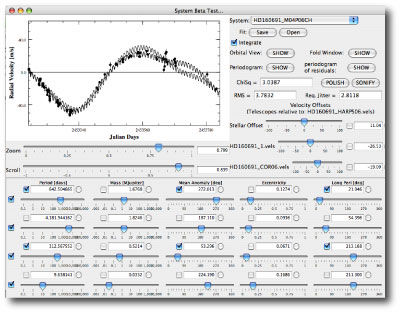
Higher resolution version here.
Having produced the fit, I saved it in my fits subdirectory (which is provided along with the downloadable version of the systemic console) and then uploaded the fit to the systemic back-end. Upon doing so, I found to my chagrin that Eugenio had arrived first, with a slightly better fit! His reduced chi-square of 3.00 arises from fitting for all 23 free parameters rather than just the six listed above.
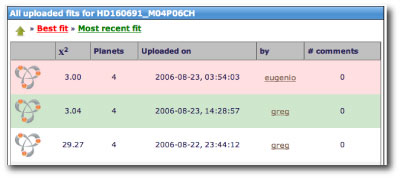
The current best fit to the Mu Ara planetary system is almost certainly not the last word on the true system configuration. For starters, the best-fit self-consistent configuration is unstable. Pepe et al. report that it self-destructs in 76 million years. My chi-square=3.04 fit to the data set also appears to be unstable. It is almost certainly true that there are stable configurations located very nearby in parameter space, but nevertheless, the architecture of the present best-fit system bugs me. It’s very strange that planets b and d are not in 2:1 mean motion resonance. Presumably, they formed further out in the protoplanetary disk (where ices were available) and then migrated in to their current positions. Such migration almost certainly would have lead to capture into the 2:1 resonance, producing a system with similar properties to those observed for GJ 876 b and c.
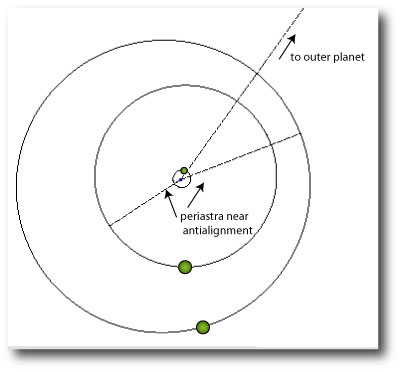
Furthermore, the longitudes of periastron for the two middle planets are close to anti-alignment in the current fit. This also suggests that the system might be near a resonant configuration. I fooled around a little bit with the orbital elements, and found that an eight-day increase in period for the second planet can bring the system into resonance.
A next step in the investigation would be to carry out fits under the constraint that the system be in 2:1 resonance. (I’ll have to use my own codes to do this, as the console is currently not configured to carry out such a project). It would also be very interesting to do a more detailed investigation of the full data set available on the console. The analysis above (which is based on the velocities used by the Pepe et al. paper) does not include the latest velocities from Butler et al. 2006’s catalog paper.
As always, when one has a multiple-planet system, it’s fun to use the console’s “sonify” function to produce an audio file of the radial velocity waveform. This .wav file corresponds to an integration of all four planets.
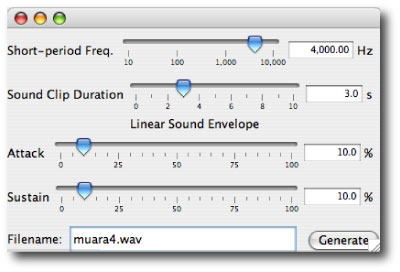
The innermost planet is audible as a high-frequency whine. If we take out the innermost planet, and keep the frequency scale of the P=312 day planet the same, one can better hear the dynamics of the interaction between the two planets near the 2:1 resonance (here’s the .wav file corresponding to the outer three planets only).
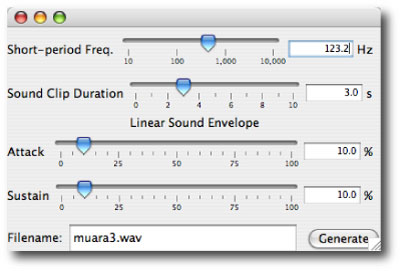

Before the announcements of the fourth planet, the hot-Neptune seems to have been referred to as d.
Pepe et al. designate the planets in order of increasing distance as c,d,b,e (which changes the designation of the hot-Neptune from d to c).
However, Gozdziewski et al. designate them as d,e,b,c (which preserves the designation of the hot-Neptune)
What’s the correct way to resolve this problem?
Do these fits include both the new RV points from the catalog (Butler, et al.) that helped Gozdziewski find the 4th planet AND the new RV points from Pepe, et al.? Analyzing this combined dataset with the console should give a better fit than either alone!
Hi
(1) I think the correct way to address the nomenclature problem is to convene an IAU committee to issue a definition.
(2) The Pepe et al dataset that we’ve been using does not include the new RV points from the Butler et al. catalog. That is, the mu Arae posts and fits so far have been based on data set “HD160691_M04P06CH” so that we could get an exact comparison with the Pepe et al results. You can do original research by fitting to HD160691_B06P06CH, which is the combination of the Pepe et al 2006 data and the Butler et al. 2006 data…
Pingback: systemic - Worlds worlds worlds